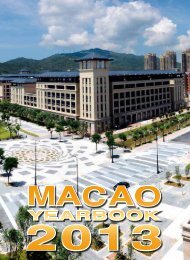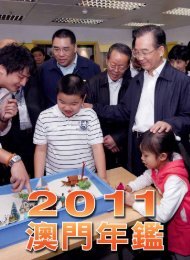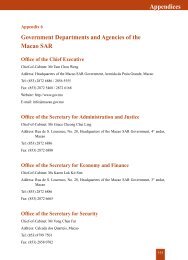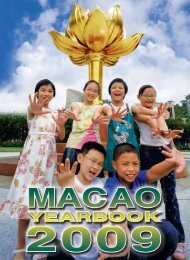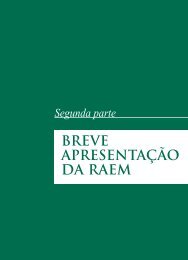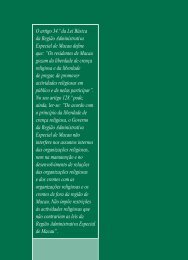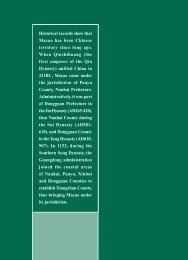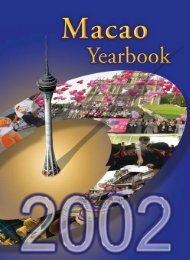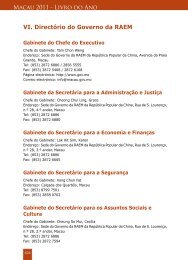Transport - Macao Yearbook
Transport - Macao Yearbook
Transport - Macao Yearbook
- No tags were found...
You also want an ePaper? Increase the reach of your titles
YUMPU automatically turns print PDFs into web optimized ePapers that Google loves.
CHAPTER 13<strong>Transport</strong>
<strong>Transport</strong> Network (Photo: Government Information Bureau)
Part 2 Chapter 13<strong>Transport</strong><strong>Transport</strong>Roads and Bridges<strong>Macao</strong> has 311.3 kilometres of roads and highways, including 180.5 kilometres on the <strong>Macao</strong>peninsula, 80.3 kilometres on Taipa island and its reclaimed areas, and 40.6 kilometres on Coloaneisland.Three bridges and a strip of reclaimed land link the <strong>Macao</strong> peninsula with Taipa and Coloane.Opened to traffic in October 1974, the Nobre de Carvalho Bridge (also known as the <strong>Macao</strong>-TaipaBridge) is 2.5 kilometres long. The 4.4-kilometre Friendship Bridge was completed in April 1994.The 2.1-kilometre Sai Van (West Bay) Bridge was completed in December 2004 and opened to trafficin January 2005. In addition, the 900-metre Lotus Flower Bridge was completed in December 1999and opened to traffic in March 2000. Linking the reclaimed area between Taipa and Coloane withZhuhai City’s Hengqin island and connected to the Guangzhou-Zhuhai Expressway, this bridge isthe second land route between <strong>Macao</strong> and its neighbouring cities.<strong>Macao</strong> has 416 kilometres of roads for motor vehicles. This figure includes 199.6 kilometres onthe <strong>Macao</strong> peninsula, 133.8 kilometres on Taipa island and its reclaimed areas, 61.4 kilometres onColoane island, five kilometres on Nobre de Carvalho Bridge, 10.2 kilometres on the FriendshipBridge, 4.2 kilometres on the Sai Van Bridge and 1.8 kilometres on the Lotus Flower Bridge.Public <strong>Transport</strong><strong>Macao</strong> has a well-established public transport network connecting the <strong>Macao</strong> peninsula and the twoislands. A variety of vehicles, including buses and taxis, are available for local residents and tourists.Public Bus ServiceThe new bus service in <strong>Macao</strong> was launched on 1 August 2011. The total number of busoperators increased from two to three. At the end of 2011, there were 656 buses in service,including 225 minibuses, 159 medium buses and 272 large buses, running 61 bus lines.The Government signed a seven-year contract with <strong>Transport</strong>es Urbanos de Macau,<strong>Transport</strong>es Companhia de Macau and Reolian Public <strong>Transport</strong> for the provision of massroad passenger transport in <strong>Macao</strong>. According to the contract provisions, the three companiesprovide services, vehicles, equipment, staff and supporting facilities, and received servicecharges specified in the contract with the Government.Sociedade de <strong>Transport</strong>es Colectivos de MacauSociedade de <strong>Transport</strong>es Colectivos de Macau (TCM) (previously known as Companhia de<strong>Transport</strong>e de Passageiros entre Macau e as Ilhas) originally provided maritime passengertransportation services between <strong>Macao</strong> and the two islands. During the 1950s, it acquired severalbus companies that served residents of Taipa and Coloane, and began to operate public buses.In 1986, Companhia de <strong>Transport</strong>e de Passageiros entre Macau e as Ilhas was restructured asTCM. Under the former Portuguese administration’s traffic and transportation policy, the company447
<strong>Macao</strong> <strong>Yearbook</strong> 2012fully operated the public buses serving <strong>Macao</strong> and its islands.In August 2011, TCM entered a new government-led stage. It also purchased 63 buses thatmeet Euro IV standards. TCM now has a fleet of 145 buses and operates 13 bus lines on <strong>Macao</strong>peninsula connecting the <strong>Macao</strong> peninsula and the outlying islands. In 2011, it carried over 33.5million passengers and covered 10.13 million kilometres.<strong>Transport</strong>es Urbanos de Macau (Transmac)<strong>Transport</strong>es Urbanos de Macau (Transmac) was previously known as Companhia de AutocarrosFok Lei. Founded in 1952, it was restructured and changed its name to <strong>Transport</strong>es Urbanos deMacau in July 1988. It is the largest bus company in <strong>Macao</strong>. The company introduced the ISOQuality Management System in 2004 for overall management, making it the first franchised buscompany in <strong>Macao</strong> to have passed ISO 9001:2008 Quality Management System.There are more than 600 employees in Transmac, operating 21 bus lines with a fleet of 276air-conditioned buses, covering <strong>Macao</strong>, Taipa and Coloane islands. During 2011, it carried over75 million passengers and covered about 16 million kilometres.Reolian Public <strong>Transport</strong>Reolian Public <strong>Transport</strong> is a joint venture between Veolia <strong>Transport</strong> RATP and HN Group.It has a strong management team and technicians with varied expertise from <strong>Macao</strong>, France,Australia, the US, mainland China and Hong Kong.Reolian began operations in August 2011. It operates 26 bus lines with a fleet of 245 buses,covering 16 million kilometres a year. From 1 August to 31 December 2011, it carried 22.5 millionpassengers.TaxisAt the end of 2011, <strong>Macao</strong> had 880 licensed black taxis with cream roofs, plus 100 radio-dispatchedyellow taxis. There were 10,236 licensed taxi drivers.Traffic Management<strong>Transport</strong> BureauThe <strong>Transport</strong> Bureau was established in May 2008. It is responsible for: studying, planning,promoting and implementing road transport policies of the Government; pursuing roadimprovements; regulation of vehicles; as well as installing, maintaining and improving transportationand pedestrian infrastructure.Vehicle StatisticsAt the end of 2011, there were 206,349 vehicles on <strong>Macao</strong>’s roads, including 111,198 motorcycles,and 95,151 light vehicles. During the year, 17,702 new vehicles were registered, a slight increaseof 10.09 percent over the 2010 figure. Of these, 9,390 were motorcycles and 7,632 were cars.448
<strong>Transport</strong>Traffic MonitoringTraffic management and monitoring are essential for ensuring the safe and orderly operation ofthe transport system. The Government has installed closed circuit TV (CCTV) and radar speedmonitoring systems to monitor traffic conditions on the <strong>Macao</strong>-Taipa Bridge and main roads.They include 30 video cameras and six two-way speed monitoring spots on the Friendship Bridge,52 video cameras and two one-way speed monitoring spots on the Sai Van Bridge, and 10 videocameras and two two-way speeding monitoring spots on the Ponte Governador Nobre de Carvalho.Also, 137 video cameras, 13 speed monitoring radar units, and 22 sets of electronic systems witha total of 73 cameras for monitoring vehicles jumping red lights have been installed in variousdowntown locations. During 2011, the monitoring systems identified 8,493 cases of speeding and1,861 cases of red light jumping.ParkingAs of 31 December 2011, <strong>Macao</strong> had 31 public car parks, which together provide 9,611 parkingspaces for light vehicles, 954 spaces for heavy vehicles, and 5,544 spaces for motorcycles.Public Car Parks in <strong>Macao</strong>Name of car parkPak Lane Car ParkPak Tou Car ParkPak Lai Car ParkPak Lik Car ParkPak Lok Car ParkPak Vai Car ParkPak Kai Car ParkPak Wai Car ParkPak Keng Car ParkPak Ying Car ParkPak Wu Car ParkPak Kong Car ParkAvailable parking spaces519 light vehicles211 light vehicles355 light vehicles417 light vehicles471 light vehicles, 300 motorcycles502 light vehicles208 light vehicles1,019 light vehicles171 light vehicles722 light vehicles682 light vehicles, 196 motorcycles287 light vehicles, 31 heavy vehicles449
<strong>Macao</strong> <strong>Yearbook</strong> 2012(Cont.)Public Car Parks in <strong>Macao</strong>Name of car parkSewage Treatment Plant Car ParkVasco da Gama Garden Car ParkIao Hon Park Multi-Storey Car ParkArt Garden Car ParkFerreira do Amaral Roundabout Car ParkHo Yin Garden Car ParkMalaca Street Car ParkTaipa Temporary Heavy Vehicle Parking AreaFlor de Lotus Road Heavy Vehicle Car ParkAvailable parking spaces276 light vehicles, 459 heavy vehicles171 light vehicles, 113 motorcycles406 light vehicles, 404 motorcycles351 light vehicles, 446 motorcycles247 light vehicles, 632 motorcycles415 light vehicles, 542 motorcycles215 light vehicles, 563 motorcycles224 heavy vehicles240 heavy vehiclesS. Lourenco Market Car Park 60 light vehicles, 74 motorcycles<strong>Macao</strong> Science Center Car ParkLido Car Park<strong>Transport</strong> Bureau Car ParkCheng Choi Building Car ParkMong Sin Block Car ParkAlmirante Sergio Road Car ParkFai Fu Building Car ParkFlor de Lotus Road Car ParkTranquilidade Road Car Park415 light vehicles, 413 motorcycles62 light vehicles, 24 motorcycles148 light vehicles, 178 motorcycles304 light vehicles, 518 motorcycles133 light vehicles, 236 motorcycles155 light vehicles, 106 motorcycles215 light vehicles, 194 motorcycles416 light vehicles, 512 motorcycles58 light vehicles, 93 motorcyclesAs at 31 December 2011, there were 10,319 parking meters and 3,443 non-metered parkingspaces. There were also 40,925 motorcycle parking spaces.450
<strong>Transport</strong>Road SafetyThe Road Traffic Law promotional campaign was held in 2011, and was jointly organised by thePublic Security Police, the Legal Affairs Bureau, the Civic and Municipal Affairs Bureau, theLands, Public Works and <strong>Transport</strong> Bureau, and several non-governmental organisations. It aimedto publicise the importance of obeying traffic regulations, and to strengthen the understanding oflaws and a sense of road safety among local residents, thus reducing the number of traffic accidents.The Traffic Department of the Public Security Police also teamed up with schools, transportationcompanies and non-governmental organisations to stage games and lectures related to road safety.Their objective was to reinforce residents’ understanding of road safety by means of long-termeducational efforts. During 2011, a total of 8,191 people from 108 schools and 10 other organisationsparticipated in the Traffic Department’s road safety promotional activities.Cross-border TrafficCross-border Land RoutesTwo land routes link <strong>Macao</strong> and mainland China: the Border Gate and Lotus Flower BridgeCheckpoint (COTAI Checkpoint). The volume of cross-border traffic has grown rapidly, in linewith increasing exchanges between <strong>Macao</strong> and the mainland.The Border Gate Checkpoint is open to passengers from 7.00am to midnight daily, and for cargofrom 7.00am to 9.00pm (except for authorised vehicles). The Lotus Flower Bridge Checkpoint isopen to passengers from 9.00am to 8.00pm, and for cargo from 8.00am to 8.00pm. The Zhuhai-<strong>Macao</strong> Crossborder Industrial Zone Border Checkpoint is open 24 hours per day.The Zhuhai-<strong>Macao</strong> Crossborder Industrial Zone Border Checkpoint officially commencedoperations on 18 October 2006. During 2011, 141,011 <strong>Macao</strong> residents crossed the border throughthe checkpoint.Some 4,135,910 vehicles entered or left <strong>Macao</strong> by land during 2011. Regarding container cargotransportation: 4,550 containers entered or left <strong>Macao</strong> (including re-exports).During 2011, 15,299,600 visitors arrived in <strong>Macao</strong> by land, an increase of 16.9 percent over theprevious year’s figure. Of these, 14,160,602 entered via the Border Gate; tourists from mainlandChina and Hong Kong represented 81.6 percent and 12.5 percent of the total, respectively. Thenumber of visitors who arrived via the Lotus Flower Bridge Checkpoint was 1,115,719. Duringthe year, arrivals of <strong>Macao</strong> residents via the Border Gate totalled 24,213,705, with 385,341 via theLotus Flower Bridge Checkpoint.Cross-Border Marine <strong>Transport</strong>ation ServicesThe Outer Harbour Ferry Terminal, Taipa Ferry Terminal, and Inner Harbour Ferry Terminal providecross-border transportation services for passengers travelling between <strong>Macao</strong> and Hong Kong andthe mainland. Scheduled passenger ferries to Hong Kong and the mainland are operated by theShun Tak-China Travel Ship Management Limited; Far East Hydrofoil Company; Hong Kong-Macau Hydrofoil Company; First Ferry (Macau); Yuet Tung Shipping Company; Cotai Waterjets(Macau) Limited; Hong Kong North West Express Limited; and <strong>Macao</strong> Dragon Company Limited(closed on 15 September 2011).451
<strong>Macao</strong> <strong>Yearbook</strong> 2012Outer Harbour Ferry TerminalThe Outer Harbour Ferry Terminal commenced operations in 1993. Its two vertical piers provide14 berths for a total of 14 passenger vessels at one time. The main building has a floor area of over6,000 square metres, with a helicopter pad on its rooftop.The Government commenced the Outer Harbour Ferry Terminal expansion project in late2006, with an aim of increasing the usable area inside the terminal, easing pressure arising fromthe sharp increase in visitors. The Government installed a self-service clearance system in 2009,and from 2009 to 2011 undertook improvement work at public facilities, including upgrading thenew centralised air-conditioning system, adding new roofs, installing electronic displays, assigningpassenger waiting area and meeting area, as well as constructing lifts and barrier access outsidethe harbour, to provide a more comfortable environment.The Government plans to commence enhancement work of the Outer Harbour Ferry Terminalin 2012, through improving the overall layout to streamline passenger flow and luggage transfer,to provide quality and convenient services to residents and visitors.As the operation management contract of the Outer Harbour Ferry Terminal ended in December of2011, the management of the harbour was led by the Government starting from 21 December 2011.Taipa Ferry TerminalTo tie in with the development of the gaming industry and the islands, ease congestion at the OuterHarbour Ferry Terminal – which is operating at maximum capacity, divert visitors, and developmaritime networks between <strong>Macao</strong> and nearby cities in the mainland, the Government decidedto build a new ferry terminal with a total area of 17,000 square metres, next to the airport in PacOn, Taipa.The temporary Taipa Ferry Terminal commenced operations in October 2007, and is an interimfacility providing two regular berths and one large berth. When the permanent ferry terminal opens,it will provide a berth for 16 400-passenger ferries, three berths for larger ferries and a helicopterpad on its rooftop.Inner Harbour Ferry TerminalThe Inner Harbour Ferry Terminal was officially put into service in February 2008, and moved fromterminal 14 to terminal 11A with a building area of over 1,200 square metres. The ferry terminaloperated three routes to Wanzai District, with three ferries operating from 8.00am to 6.00pm.There were 121,323 scheduled ferry sailings between <strong>Macao</strong> and Hong Kong during 2011, adecrease of 1.27 percent on the previous year’s figure. There were also 20,176 scheduled ferrysailings between <strong>Macao</strong> and mainland China, a decrease of 22.56 percent on the 2010 figure.During 2011, passengers arriving at <strong>Macao</strong> by sea numbered 12,365,302, an increase of 20.71percent over the 2010 figure. Of these, 8,283,122 entered <strong>Macao</strong> via the Outer Harbour FerryTerminal. In all, 322,928 visitors entered <strong>Macao</strong> via the Inner Harbour, and 3,759,252 entered viathe Taipa Temporary Ferry Terminal.In 2011, 74,903 containers or 101,989 TEUs (twenty-foot equivalent units) were shipped in452
<strong>Transport</strong>and out of <strong>Macao</strong> by sea, representing increases of 14.76 percent and 11.69 percent, respectively,on the 2010 figures.Cross-Border Helicopter ServicesHelicopter is the most convenient way to travel between <strong>Macao</strong> and Hong Kong. A helicopterpassenger transportation service was inaugurated in November 1990. Jointly operated by HelicoptersHong Kong (Heli HongKong) and East Asia Airlines, the service has reduced the travelling timebetween Hong Kong and <strong>Macao</strong> to only 16 minutes. It operates from 9.00am to 11.00pm, withscheduled flights in each direction every 30 minutes. In addition, East Asia Airlines began operatingdaily passenger helicopter flights between <strong>Macao</strong> and Shenzhen in April 2002. In 2011, there were16,335 helicopter flights to and from Hong Kong via the Outer Harbour Ferry Terminal, and therewere 3,671 flights between mainland China and <strong>Macao</strong>.PortsOuter HarbourLocated on the east coast of the <strong>Macao</strong> peninsula, the Outer Harbour is designated for scheduledferries between <strong>Macao</strong> and Hong Kong and Shenzhen. Its watercourse is 120 metres wide and 4.4metres deep.To streamline the sea passageway to the east of Friendship Bridge, the Maritime Administrationrestructured a fairway off eastern Friendship Bridge leading to the Inner Harbour, making the fairwaystraight and setting up a more advanced system of synchronised flashing beacons.Inner HarbourLocated on the west coast of the <strong>Macao</strong> peninsula, the Inner Harbour has many piers for loadingand discharging cargo, plus Pier 14, which is for passengers using ferries licensed by the MaritimeAdministration. The South Sampan Pier between Piers 8 and 9 is used by crewmembers of shipsberthed in the Inner Harbour who hold <strong>Macao</strong> ID Cards, or who are authorised to land and departby the relevant Government authority, with prior notice to the <strong>Macao</strong> Customs Service. The InnerHarbour’s approach channel is 45 metres wide, and its fairway is 55 metres wide and 3.5 metresdeep.TaipaThe Taipa Temporary Ferry Terminal is situated on the north-eastern tip of Taipa island, and isexclusive for scheduled high-speed ferries shuttling between <strong>Macao</strong> and Hong Kong, and between<strong>Macao</strong> and the Pearl River Delta area. Its fairway is 120 metres wide and 4.4 metres deep.Ka Ho HarbourLocated on the northeast shore of Coloane island, Ka Ho Harbour consists of the Fuel Oil Terminal,Cement Terminal, Ka Ho Container Port, and Power Plant Terminal. Its approach channel is 75metres wide and 4.4 metres deep.453
<strong>Macao</strong> <strong>Yearbook</strong> 2012Ka Ho Container Wharf and Fuel Oil TerminalPhase One of Ka Ho Container Wharf commenced operations in December 1991. With a totalconstruction area of 42,000 square metres (now 49,524 square metres), it includes a container wharf,container yard and warehouses. At present, it has two berths, of 135 metres and 171.4 metres inlength; a 10,428-square-metre cargo working area; a 23,828-square-metre container yard; and 2,850square metres of cargo warehousing space. The terminal’s annual handling capacity is 100,000 TEUs.In 2011, Ka Ho Harbour handled 5,651 inbound TEUs (twenty-foot equivalent units) and 7,080outbound TEUs; both figures include re-exports.The Fuel Oil Terminal commenced operation in June 1995. It can store a wide variety of fueloil imported into <strong>Macao</strong>, and can simultaneously load and unload two fuel-carrying vessels. It has14 storage tanks with a combined capacity of 86,000 cubic metres.Maritime AdministrationThe Maritime Administration is a department with authorities and duties relating to maritimeaffairs, and is responsible for exercising its power to promote and coordinate the development ofmaritime activities.To promote and assist economic development of the fishery sector, in 2007 the Governmentpromulgated By-law No. 3/2007 to establish the Fisheries Development and Support Fund.The Maritime Administration started to receive applications for the Fisheries Developmentand Support Fund on 30 April 2007. The loans approved amounted to about 30 million patacas.Port Management and ServicesVessel InspectionsTo ensure navigational safety and effectively manage marine transportation, local vessels navigatingin <strong>Macao</strong>’s waters are required to undergo annual maintenance and special inspections. In addition,they must have navigation licences issued by the relevant authorities in <strong>Macao</strong>. The MaritimeAdministration conducts regular, random inspections of foreign vessels berthing in <strong>Macao</strong>’s portsand conducting activities in <strong>Macao</strong>’s traditional waters, according to the nature of their activities,to ensure they comply with international treaties regarding marine safety and the prevention ofpollution.Pilot ServicesThe Maritime Administration provides pilot services for vessels entering and leaving <strong>Macao</strong> via theinner and outer channels, within berthing areas, and in all waters under the Government’s jurisdiction.Ships navigating the Ka Ho Harbour, Outer Harbour and Inner Harbour are required to usepilot services. However, scheduled high-speed passenger ferries, ships controlled by captainsholding pilot exemption licences, vessels navigating within the harbour, local auxiliary boats,<strong>Macao</strong> and neighbouring coastal fishing boats and pleasure craft are eligible for exemption fromthis requirement.454
<strong>Transport</strong><strong>Macao</strong> Vessel Traffic Control CentreThe <strong>Macao</strong> Vessel Traffic Control Centres (<strong>Macao</strong> VTS) in the Outer Harbour Ferry Terminal andthe temporary Taipa Ferry Terminal are mainly responsible for carrying out mandatory monitoringof vessels within <strong>Macao</strong>’s traditional waters, especially high-speed passenger vessels navigatingto or from the Outer Harbour Ferry Terminal and Taipa Ferry Terminal. It also has the role ofproviding safety-related information to vessels via radio, in order to ensure that they navigate ina safe environment.The <strong>Macao</strong> VTS conducts round-the-clock monitoring of VHF channel 16 and VHF DSC channel70 of the Global Maritime Distress Safety System (GMDSS), and provides prompt maritime rescueand emergency assistance if a distress signal is received.Search and Rescue OperationsMaritime search and rescue are crucial tasks for the port service. The most common types ofincidents of this nature are stranding, collisions, fires, fuel leakages and pollution. The MaritimeAdministration and the <strong>Macao</strong> Customs Service bear the main responsibility for salvage work. Inaddition, the Maritime Administration has reached agreements with relevant authorities in HongKong and Zhuhai, under which the Search and Rescue Coordination Centre can request their supportto bolster its salvage efforts.Hydrographic SurveyThe Maritime Administration’s Hydrography Centre is responsible for conducting hydrographicsurveys. Any eligible entity or institute may apply for its services. Survey fees are stipulated in itsrelevant regulations.DredgingThe Maritime Administration’s Centre for Dredging Works is responsible for monitoring dredgingwork in <strong>Macao</strong> waters. The centre operates two non-motor-driven dredging boats, a barge for silttransportation and an auxiliary boat to perform dredging work (except those areas for which theSociedade de Jogos de Macau (SJM) is responsible, as stipulated in casino gaming contracts).Port CleaningThe Maritime Administration is responsible for clearing up waste and pollutants in the sea. A majorfocus is to prevent marine pollution caused by solid waste. The solid waste it collects includes loosewooden frames and boards, waste and refuse from boats, and hydrophytes such as water lettuce.Exchange and Cooperation with Overseas Organisations<strong>Macao</strong> joined the International Maritime Organization (IMO) as an associate member in 1990. Sincethen, the Maritime Administration has dispatched officials to represent <strong>Macao</strong> at IMO conferencesand annual meetings. International treaties on maritime safety and the prevention of pollution havebeen extended to include <strong>Macao</strong>, and they were enacted by the MSAR in 1999. The Government455
<strong>Macao</strong> <strong>Yearbook</strong> 2012has designated the Maritime Administration as the competent authority for internal and externalactivities relating to international maritime treaties, including flag state implementation.ShipsMaritime RegistrationBy law, all vessels engaged in economic activities – including freighters, passenger vessels,fishing boats and auxiliary boats – must be registered with the Maritime Administration and theCommercial and Movable Goods Registry. The registration procedures are designed to verify itsconformity with official requirements concerning technology, safety and environmental protection.Maritime registration is a prerequisite for vessels requiring commercial registration. There were299 registered vessels at the end of 2011, including five that were newly registered during the year.In addition, maritime and commercial registration is required for vessels over 2.5 metres inlength that are used for non-profit-making purposes, such as water sports, fishing or recreationalactivities. These include ocean-going, coastal, inshore, channel and river pleasure boats. Therewere 100 registered vessels in this category at the end of 2011, including nine new registrations.Seafarer RegistrationAccording to the law, <strong>Macao</strong> residents aged 18 or above may apply for seafarer registration withthe Maritime Administration. All <strong>Macao</strong> residents who wish to conduct professional maritimeactivities on commercial vessels, auxiliary boats or fishing boats are required to register with theMaritime Administration beforehand. At the end of 2011, 251 people held seafarer’s books issuedby the Maritime Administration.Maritime Training SchoolThe Maritime Training School is <strong>Macao</strong>’s only nautical education institution. Its principal objectivesare to provide theoretical and practical training in maritime subjects and harbour management, aswell as related scientific knowledge.Most of the training school’s students are Maritime Administration and <strong>Macao</strong> Customs Servicestaff members, as well as sailors, fishermen and nautical athletes in <strong>Macao</strong>. The training schoolalso provides after-school and summer vacation activities for youngsters.The ShipyardThe Shipyard is a department under the Maritime Administration. Apart from shipbuilding and shiprepairs, it is responsible for maintaining and repairing Government vehicles, verifying their statusand inspecting them, as well as making and installing the vehicle identification plates for variousGovernment departments. At present, most of the vessels built and repaired at the Shipyard belongto the Maritime Administration and <strong>Macao</strong> Customs Service. In 2011, the Shipyard carried out233 vessel maintenance projects for various organisations, including the Maritime Administration,<strong>Macao</strong> Customs Service, and Macau International Airport Company. It also provided quality controlin the construction of a new, 38-metre fireboat for the Maritime Administration; it carried out 2,018projects related to the examination, maintenance and repair of vehicles.456
<strong>Transport</strong>Civil AviationCivil Aviation AuthorityThe Civil Aviation Authority was founded on 4 February 1991, in accordance with Decree-LawNo. 10/91/M dated 4 February 1991. It is constituted as a public institution under the Secretariatfor <strong>Transport</strong> and Public Works, and it enjoys autonomy over administration, finances and property.It is responsible for directing, controlling and monitoring all civil aviation activities in <strong>Macao</strong>, andthe operations of all aircraft registered in <strong>Macao</strong>.Aviation ServiceTo implement its “Open Skies” policy, the Government has adopted a series of measures to enhance<strong>Macao</strong>’s civil aviation infrastructure network. Every effort has been made to attract additionalinvestment from domestic and foreign airlines, to promote the use of Macau International Airport,and to enhance the development of passenger and cargo transportation.To increase cooperation with the international aviation community, the Government willcontinue to forge new air services agreements with countries around the world. By 31 December2011, <strong>Macao</strong> had initialled air services agreements with 47 nations and regions; 40 of these wereofficially signed.Signatories of Air Services Agreements with <strong>Macao</strong>NationSigning dateBrazil 15/07/1994Finland 09/09/1994Austria 04/11/1994Belgium 16/11/1994The Netherlands 16/11/1994Luxembourg 14/12/1994New Zealand 09/03/1995Portugal 31/08/1995Switzerland 05/09/1995Singapore 27/10/1995Malaysia 31/10/1995Thailand 01/11/1995457
<strong>Macao</strong> <strong>Yearbook</strong> 2012(Cont.)Signatories of Air Services Agreements with <strong>Macao</strong>NationSigning dateUnited States 03/07/1996Vietnam 07/08/1996Germany 05/09/1996DPR Korea 08/12/1996Denmark 11/12/1996Sweden 11/12/1996Norway 11/12/1996South Korea 03/04/1997The Philippines 18/07/1997India 11/02/1998Nepal 19/02/1998South Africa 04/04/1998Brunei 24/05/1998United Arab Emirates 06/12/1998Russia 21/01/1999Myanmar 12/03/1999Australia 24/08/1999Poland 22/10/1999Pakistan 15/11/2000Czech Republic 25/09/2001Cambodia 12/12/2001United Kingdom 19/01/2004Iceland 13/07/2004Maldives 16/01/2006France 23/05/2006458
<strong>Transport</strong>(Cont.)Signatories of Air Services Agreements with <strong>Macao</strong>NationSigning dateSri Lanka 08/06/2006Mongolia 27/06/2006Japan 10/02/2010LaosOmanIndonesiaIsraelGreeceSlovakiaCape VerdeInitialledInitialledInitialledInitialledInitialledInitialledInitialledAs at 31 December 2011, four airlines were registered in <strong>Macao</strong> and providing flight services:Air Macau, East Asia Airlines, JetAsia and Macau Jet International.Below are details of the fleets and routes that they operated:Airline Fleet DestinationsAir Macau 5 x Airbus A319,2 x Airbus A320,7 x Airbus A321,2 x Airbus A300B4-622RBeijing, Chengdu, Hangzhou,Nanjing, Shanghai (Pudong,Hongqiao), Hefei, Ningbo,Xiamen, Nanning,Chongqing, Taiyuan, Taipei,Kaohsiung, Bangkok,Singapore, Seoul, Tokyo,OsakaEast Asia Airlines(Helicopter service)3 x Agusta AW139 Hong Kong, ShenzhenJetAsia(Commercial charter flightservices)2 x Challenger CL600-2B16,2 x Hawker 900XP,4 x Hawker 750Global destinationsMacau Jet International(Commercial CharterServices)1 x Falcon 2000LX Global destinations459
<strong>Macao</strong> <strong>Yearbook</strong> 2012The numbers of pilots licensed by the Civil Aviation Authority, as at 31 December 2011, were:AirlineNumber of licensed pilotsCivil Aviation Authority 2Air Macau 163East Asia Airlines 32JetAsia 4Macau Jet International (Commercial CharterServices)5Total 206Macau International Airport is located at the eastern end of Taipa island and neighbouringwaters. The terminal building was constructed on a rock-cut platform at Ponta da Cabrita, whilethe apron was built on reclaimed land. East of the apron, the air-traffic control building, controltower and ancillary fire station are on Kia Kiong Islet. The runway is on an artificial island linkedto the apron by two taxiway bridges.The main fire station is on the runway island, next to the oblique taxiway. The airport is withineasy reach of the <strong>Macao</strong> peninsula, the Outer Harbour and Zhuhai via motorway, the FriendshipBridge and the Lotus Flower Bridge. Commuting times from all these points are less than 20 minutes.Macau International Airport handled 4,045,014 passengers during 2011, a decrease of 0.8 percenton the 2010 figure. Its cargo volume totalled 39,523 tonnes, a decrease of 24.2 percent. A total of38,946 flights took off and landed, an increase of 4.8 percent.Private and commercial air charters saw an increase in the number of flights, from 954 flightsin 2010 to 1,010 flights in 2011, an increase of 5.9 percent.Air Traffic ControlSince it opened in 1995, the airport’s air traffic control system has maintained excellent standardsof service efficiency and flight safety. Air traffic control facilities include secondary surveillanceradar and the Automatic Terminal System. Telecommunications facilities include AMHS andsatellite ground stations, while air-ground communications facilities include a UHF radio station.<strong>Macao</strong>’s air traffic zone is classified as Category-C under International Civil Aviation Organization(ICAO) standards. The keyhole-shaped air traffic zone is centred on Macau International Airport.It extends up to an altitude of 3,000 feet and a radius of five nautical miles. The western boundaryis a straight line parallel to and three nautical miles from the runway. To the south, the zone formsa rectangle five nautical miles wide and extending southwards for 10 nautical miles.<strong>Macao</strong>’s air traffic zone lies between the Hong Kong and Guangzhou flight information zones.460
<strong>Transport</strong>All aircraft, including helicopters entering <strong>Macao</strong> airspace, are supervised by the airport controltower. Arriving and departing aircraft can land or take off from both the southern and northernapproaches. The mainland authorities control air traffic to the north of <strong>Macao</strong>’s air zone, whiletraffic to the south is controlled by the Civil Aviation Department of Hong Kong. Since traffic inthe Pearl River Delta airspace is busy and complex, the air-traffic control authorities of <strong>Macao</strong>,the mainland and Hong Kong must work closely together to ensure the safety and efficiency of airtraffic in <strong>Macao</strong> and the neighbouring air zone.Aircraft NoiseMacau International Airport was constructed offshore and far from residential communities,avoiding the need to install soundproofing. However, to protect Zhuhai from noise pollution causedby northbound flights taking off from the runway, aircraft are not allowed to pass the 230-degreeradial line of Zhuhai’s Jiuzhou omni-directional beacon station.Security at Macau International AirportUnder Decree-Law No. 36/94/M issued on 18 July 1994 and ICAO regulations, the security systemsat Macau International Airport are intended to ensure the safety, normal operations and efficiency ofinternational civil aviation activities at the airport. Security measures and procedures are essential toprotect passengers, crew, airport staff and the public, as well as ensuring the normal, uninterruptedoperations of aircraft, facilities and equipment.Airport security falls under the responsibility of the Civil Aviation Authority, the Unitary PoliceService, the <strong>Macao</strong> Customs Service, the Public Security Police, the Judiciary Police, the FireService, the Maritime Administration, the airport itself, Companhia de Seguranca de Macau Lda(SEMAC), the private airport security company, aviation companies and other airport departments.The private airport security company is responsible for implementing the security measures andprocedures formulated by the airport operator, and ensuring that the security measures and procedurescomply with the International Civil Aviation Organization (ICAO) standards and recommendations.Besides, the company provides professional training, certified technicians and advanced securityequipment to perform security checks on passengers, baggage and cargo.Macau International Airport CompanyMacau International Airport Company (CAM) has been appointed by the Government to operateMacau International Airport. It was responsible for the airport’s construction, and it is nowresponsible for its operation. The Government has approved the company’s application in 2001 toextend the period of its franchise by a further 25 years to 2039.461
<strong>Macao</strong> <strong>Yearbook</strong> 2012<strong>Macao</strong> <strong>Yearbook</strong> 2012462
<strong>Transport</strong>The Secretary for <strong>Transport</strong> and Public Works, Lau Si Io, attends the ground-breakingceremony of depot groundwork construction of the first phase of the Light RapidTransit System, on 23 November.The Secretary for <strong>Transport</strong> and Public Works, Lau Si Io, witnesses the signing ceremonyof “Rolling Stock & Systems for the Phase 1 of <strong>Macao</strong> Light Rapid Transit” between the<strong>Transport</strong>ation Infrastructure Office and Mitsubishi Heavy Industries, on 3 March.463
<strong>Transport</strong>The <strong>Transport</strong>ation Infrastructure Office (GIT) of the <strong>Macao</strong> SAR Government signsa memorandum with MTR Corporation Ltd of Hong Kong on technical cooperationon <strong>Macao</strong>’s Light Rapid Transit System, on 13 December.On 2 March, the <strong>Transport</strong>ation Infrastructure Office holds a presentation session to introduceroutes and station designs of the Light Rapid Transit in central Taipa.464
The inauguration ceremony of the new public bus model, which will belaunched in August 2011, is held on 31 July.465



